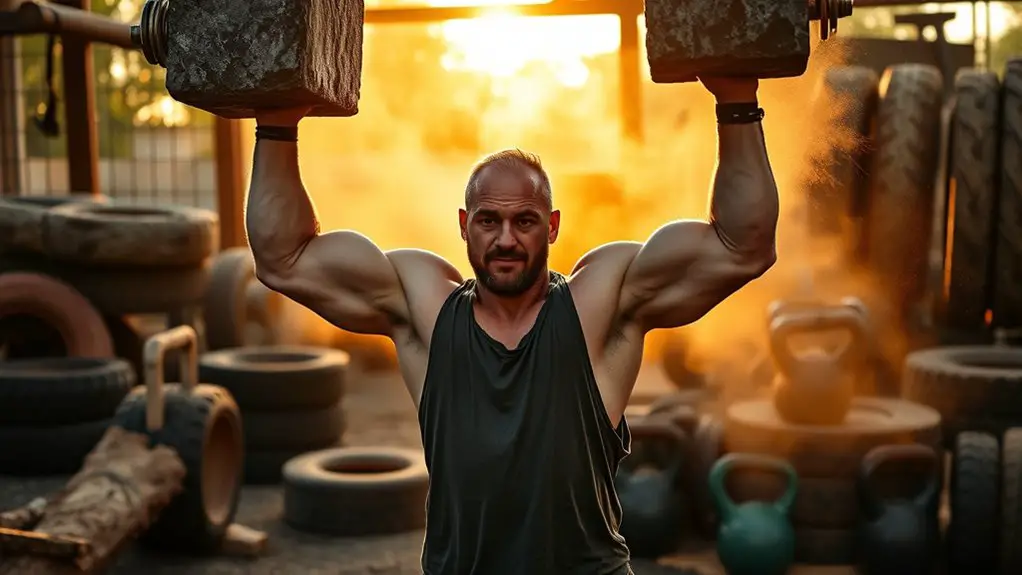Calisthenics plays an essential role in your military fitness preparation. It builds strength, endurance, and flexibility without needing any equipment. You'll find exercises like push-ups and squats enhance your functional strength and mobility, preparing you for demanding tasks. Additionally, it fosters mental resilience vital for overcoming challenges. Tailoring routines to specific roles further boosts effectiveness. There's so much more to explore about how calisthenics can enhance your readiness and performance in military settings.
The Fundamentals of Calisthenics in Military Training
Calisthenics form the backbone of military fitness training, emphasizing strength, endurance, and agility without the need for equipment. This approach to fitness gives you the freedom to train anywhere, whether it's a field, park, or your own backyard. You'll engage in exercises like push-ups, pull-ups, and squats, which not only build muscle but also enhance your overall physical performance. Incorporating calisthenics into your routine promotes functional strength, making it easier to tackle obstacles in real-life situations. You'll learn to move your body effectively, developing coordination and balance as you progress. Each workout can be tailored to your level, allowing you to push your limits and discover what you're truly capable of. Additionally, strong core muscles support better stability and control during your calisthenics exercises, enhancing your overall training effectiveness.
Building Strength Through Body Weight Exercises
When you train with body weight exercises, you tap into a powerful way to build strength without the need for equipment. These exercises offer numerous advantages, including improved functional fitness and increased mobility. Enhanced core stability is another benefit that can significantly improve your overall athletic performance. Let's explore some key calisthenics moves that can enhance your training regimen.
Advantages of Body Weight Training
While many training methods exist, body weight exercises stand out for their ability to build strength effectively and efficiently. You'll find these exercises not only liberating but practical for your fitness journey. Here are some advantages:
- Flexibility: Train anywhere—at home, in a park, or on deployment.
- Functional Strength: Improve your body's ability to perform everyday tasks, enhancing overall performance.
- Minimal Equipment: No need for fancy gear; your body is all you need to achieve great results.
- Scalability: Modify exercises to suit your fitness level, allowing for continuous progression.
Embracing body weight training gives you the freedom to customize your workout, making it an empowering choice for anyone committed to building strength.
Key Calisthenics Exercises
Body weight training offers a solid foundation for building strength, and incorporating specific calisthenics exercises can take your fitness to the next level. Start with push-ups to engage your chest, shoulders, and triceps. Next, try squats for powerful legs and core stability. Pull-ups are excellent for back strength and grip, while dips target your triceps and chest. Don't forget planks, which build core endurance and stability. Add variations to keep things fresh, like explosive push-ups or pistol squats. Remember, the beauty of calisthenics is that you can do these anywhere, giving you the freedom to train without limits. So, embrace the challenge, push your boundaries, and watch your strength soar!
Enhancing Endurance and Stamina With Calisthenics
Calisthenics can considerably boost your endurance and stamina, especially when integrated into a military fitness regimen. These bodyweight exercises not only improve strength but also enhance your cardiovascular capacity, setting you free to tackle any physical challenge. To maximize your endurance through calisthenics, focus on these key aspects:
- High-Rep Sets: Perform exercises like push-ups and squats in higher repetitions to build muscular endurance.
- Circuit Training: Combine various calisthenics moves into a circuit for continuous movement, which increases heart rate.
- Plyometrics: Incorporate explosive movements such as burpees and jump squats to improve your power and stamina.
- Progressive Overload: Gradually increase the difficulty by adding more reps, sets, or variations to keep challenging your body. Additionally, regular training in calisthenics enhances stamina and promotes muscle resilience, which is crucial for military fitness preparation.
Flexibility and Mobility: Key Components for Soldiers
Flexibility and mobility are essential for soldiers, as they help prevent injuries and improve overall performance. By focusing on joint mobility and enhancing muscle flexibility, you can guarantee your body is prepared for the physical demands of military life. Incorporating targeted calisthenics into your training routine can make a significant difference in your readiness.
Importance of Joint Mobility
While you may focus on strength and endurance in military fitness preparation, neglecting joint mobility can lead to injuries and hinder performance. Ensuring your joints are mobile is essential for overall effectiveness in the field. Here's why it matters:
- Injury Prevention: Improved mobility reduces the risk of strains and sprains.
- Enhanced Performance: Flexible joints allow for a greater range of motion, boosting your agility.
- Better Recovery: Joint mobility aids in faster recovery times after intense workouts.
- Functional Movement: It supports everyday activities and tactical maneuvers, keeping you ready for anything.
Integrating joint mobility exercises into your regimen helps you maintain freedom of movement, ensuring you're always at your best. Don't overlook this important component of military fitness!
Enhancing Muscle Flexibility
As you prepare for military fitness, enhancing muscle flexibility is crucial for optimizing your performance and reducing injury risk. Flexible muscles allow for a greater range of motion, enabling you to execute movements efficiently, whether you're sprinting, jumping, or climbing. Incorporating calisthenics like dynamic stretches, lunges, and yoga can considerably improve your flexibility. These exercises not only stretch your muscles but also promote relaxation and mental clarity. Remember, flexibility isn't just about being limber; it's about empowering your body to move freely and effectively in various situations. Regularly dedicating time to flexibility training can boost your overall physical readiness, helping you conquer challenges with confidence and agility. Embrace this essential component of your fitness journey for ultimate freedom in movement.
The Mental Resilience Gained From Calisthenics
Mental toughness is an invaluable asset cultivated through calisthenics. As you push your body through challenging movements, you also forge a resilient mindset that can enhance your performance in military training and beyond. Here are four key aspects of mental resilience gained from calisthenics:
- Overcoming Discomfort: You learn to embrace discomfort, turning challenges into stepping stones for growth.
- Building Discipline: Regular practice fosters a sense of routine, helping you stay committed to your objectives.
- Boosting Confidence: Each achievement, no matter how small, reinforces your belief in your abilities.
- Enhancing Focus: The concentration required during calisthenics sharpens your mental clarity, allowing you to tackle various challenges head-on.
Additionally, calisthenics can help develop mental toughness that is crucial for success in endurance sports. Through calisthenics, you're not just building muscles; you're cultivating a determined spirit ready to face any obstacle life throws your way.
Calisthenics vs. Traditional Weightlifting in Military Fitness
When comparing calisthenics to traditional weightlifting in military fitness, it's essential to recognize the unique benefits each method offers. Calisthenics emphasizes bodyweight movements, promoting functional strength and flexibility. You can perform them anywhere, allowing for a sense of freedom in your training routine. This adaptability means you can quickly adjust your workouts to fit your environment, whether you're in a gym or out in the field.
On the other hand, traditional weightlifting focuses on building muscle mass and strength through resistance training. It provides a structured approach to progress, as you can easily track your lifts and increase weights. However, it often requires specific equipment and may limit your training options based on available resources.
Ultimately, both methods have their place in military fitness. By blending calisthenics and weightlifting, you can harness the advantages of each, creating a balanced and effective training program that suits your needs.
Tailoring Calisthenics Routines for Different Military Roles
How can you tailor calisthenics routines to meet the diverse demands of different military roles? It's crucial to take into account the specific physical requirements each role entails. Here's how you can adapt your routines:
- Infantry: Focus on endurance and strength with exercises like push-ups, squats, and burpees. Aim for high reps to build stamina.
- Special Forces: Incorporate agility drills and explosive movements, such as plyometric push-ups and tuck jumps, to enhance your responsiveness and power.
- Medics: Prioritize core stability and functional movements, including planks and lunges, to guarantee you can handle various field situations effectively.
- Logistics: Emphasize flexibility and mobility through dynamic stretches and bodyweight exercises, making sure you're ready for the physical demands of transporting supplies.
Incorporating Calisthenics Into Daily Training Regimens
Incorporating calisthenics into your daily training regimen can greatly enhance your overall fitness and readiness for military duties. These bodyweight exercises require minimal equipment and can be done anywhere, giving you the freedom to train on your terms. Start by setting specific goals, whether it's improving strength, endurance, or agility.
Try integrating exercises like push-ups, pull-ups, squats, and planks into your routine. You can mix them up with high-intensity intervals for a dynamic workout that keeps you engaged. Aim for consistency; even short sessions can yield significant results over time. Additionally, incorporating strength training exercises into your program can further enhance your performance and prepare you for the physical demands of military service.
Don't forget to listen to your body. Rest and recovery are just as important as the workouts themselves. By making calisthenics a staple in your training, you're not only building muscle but also cultivating discipline and resilience—key attributes for anyone preparing for military challenges. Embrace the journey, and enjoy the freedom that comes with being fit and ready.
Success Stories: Calisthenics in Action
While many military personnel have benefitted from traditional strength training, countless success stories highlight how calisthenics have transformed their fitness journeys. You might find inspiration in these remarkable transformations:
- Enhanced Mobility: Soldiers report improved flexibility and movement, allowing for better performance in various tasks.
- Increased Endurance: Many have experienced a boost in stamina, enabling them to tackle long missions without fatigue.
- Strength Without Equipment: Personnel have built significant muscle using only body weight, proving that you don't need a gym to get fit.
- Mental Toughness: Calisthenics challenge you to push your limits, fostering resilience and confidence that carry over into high-pressure situations.
These stories showcase how embracing calisthenics can lead to not just physical fitness, but also a sense of empowerment. When you adopt this approach, you're not just training your body; you're releasing your potential for freedom and strength. Additionally, the incorporation of functional strength training can further enhance an athlete's performance by improving overall strength and coordination.
The Future of Calisthenics in Military Fitness Programs
As military training evolves, the integration of calisthenics into fitness programs is likely to become even more prominent, reflecting a shift towards functional strength and adaptability. You'll find that these bodyweight exercises offer a practical approach to developing the agility and endurance needed in modern combat scenarios. With minimal equipment, calisthenics can be practiced anywhere, providing flexibility that aligns with the demands of military life.
In the future, you might see calisthenics tailored to specific missions, emphasizing skills like balance, coordination, and explosive power. By incorporating these movements, soldiers can enhance their physical capabilities while fostering a deeper connection with their bodies.
Moreover, the community aspect of calisthenics encourages camaraderie and mutual support, which is essential in military settings. As you embrace this evolution, you'll not only build strength but also cultivate a mindset that values freedom, resilience, and adaptability in every challenge you face.
Frequently Asked Questions
Can Calisthenics Help With Injury Recovery for Soldiers?
Studies show that 30% of soldiers recover faster using calisthenics. You'll find these exercises enhance flexibility and strength, reducing injury risk. Embrace your freedom to move and heal through bodyweight training's power and simplicity.
What Equipment, if Any, Is Needed for Calisthenics Training?
You don't need much for calisthenics training—just your body weight and some space. A pull-up bar or resistance bands can enhance your workouts, but your determination and creativity are your best equipment.
How Do Calisthenics Improve Combat Readiness Specifically?
Calisthenics boost your combat readiness by enhancing strength, agility, and endurance. For instance, imagine a soldier mastering push-ups and pull-ups, building the explosive power needed for quick maneuvers in high-pressure scenarios. It's about freedom in movement.
Are There Calisthenics Routines Suitable for Beginners?
Absolutely, there're plenty of calisthenics routines for beginners. Start with basic exercises like push-ups, squats, and planks. They'll build your strength and endurance, setting a solid foundation for more advanced movements later on.
How Can Calisthenics Be Modified for Different Fitness Levels?
You don't need to be super fit to start calisthenics. For different fitness levels, modify exercises by adjusting reps, sets, or intensity. Embrace your journey, and you'll discover your own strength at every step.




